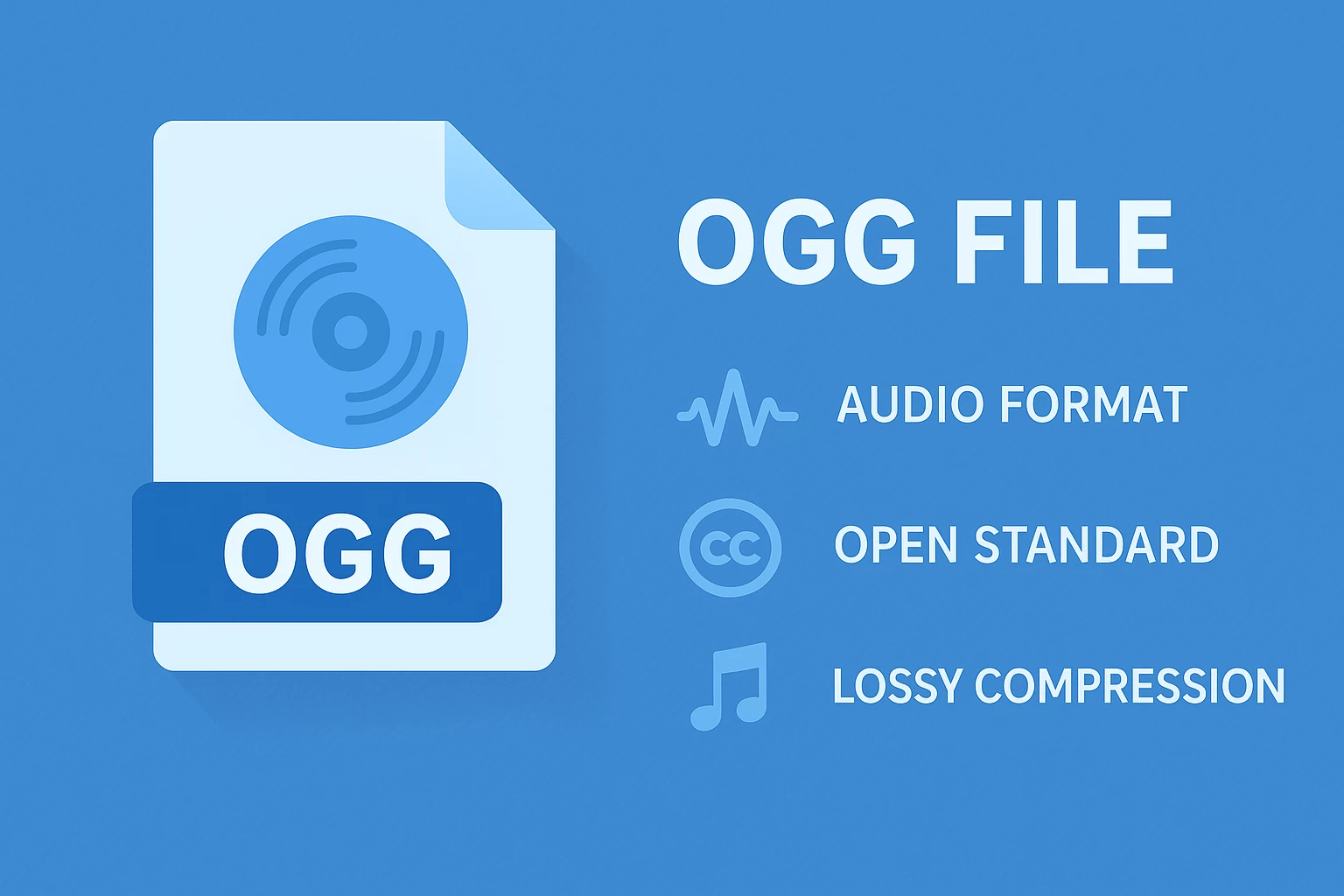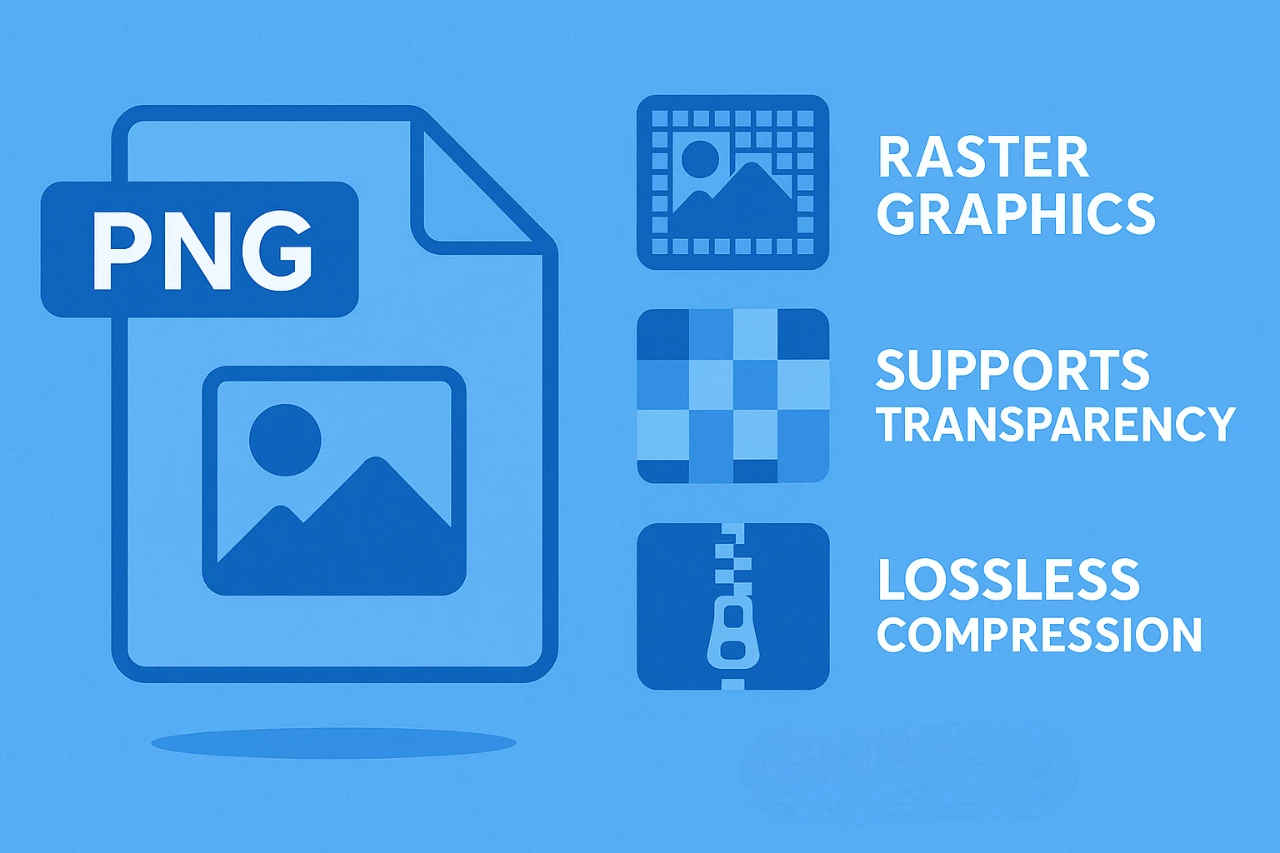
What Is a PNG? Benefits, Uses, and When to Use It
PNG files have always been part of my daily work. Whether I’m designing, editing screenshots, or preparing visuals for the web, I use PNG because it keeps image quality sharp and consistent. It’s one of those formats that simply works, delivering clear visuals, smooth transparency, and reliable results every time.
Over time, I’ve come to rely on PNG for more than just image clarity. It’s flexible enough for creative projects, technical assets, and web graphics. In this guide, I’ll explain what a PNG file is, how it works, and why it remains one of the most dependable image formats today.
Stick with me to learn how to use PNG files effectively, avoid common mistakes, and get the best results in both design and web performance.
What Is a PNG File and How Does It Work?#
I’ve always thought of PNG as the format that keeps images crisp and accurate. It stands for Portable Network Graphics, and it was created as a modern, patent-free replacement for GIF. What makes it stand out is how it maintains perfect image quality while still managing file size efficiently.
Unlike formats that reduce image quality to make files smaller, PNG uses lossless compression. Every pixel stays intact, no matter how many times I open or save the file. That’s why I trust PNG when working on graphics, icons, or web visuals that need to look sharp across different platforms.
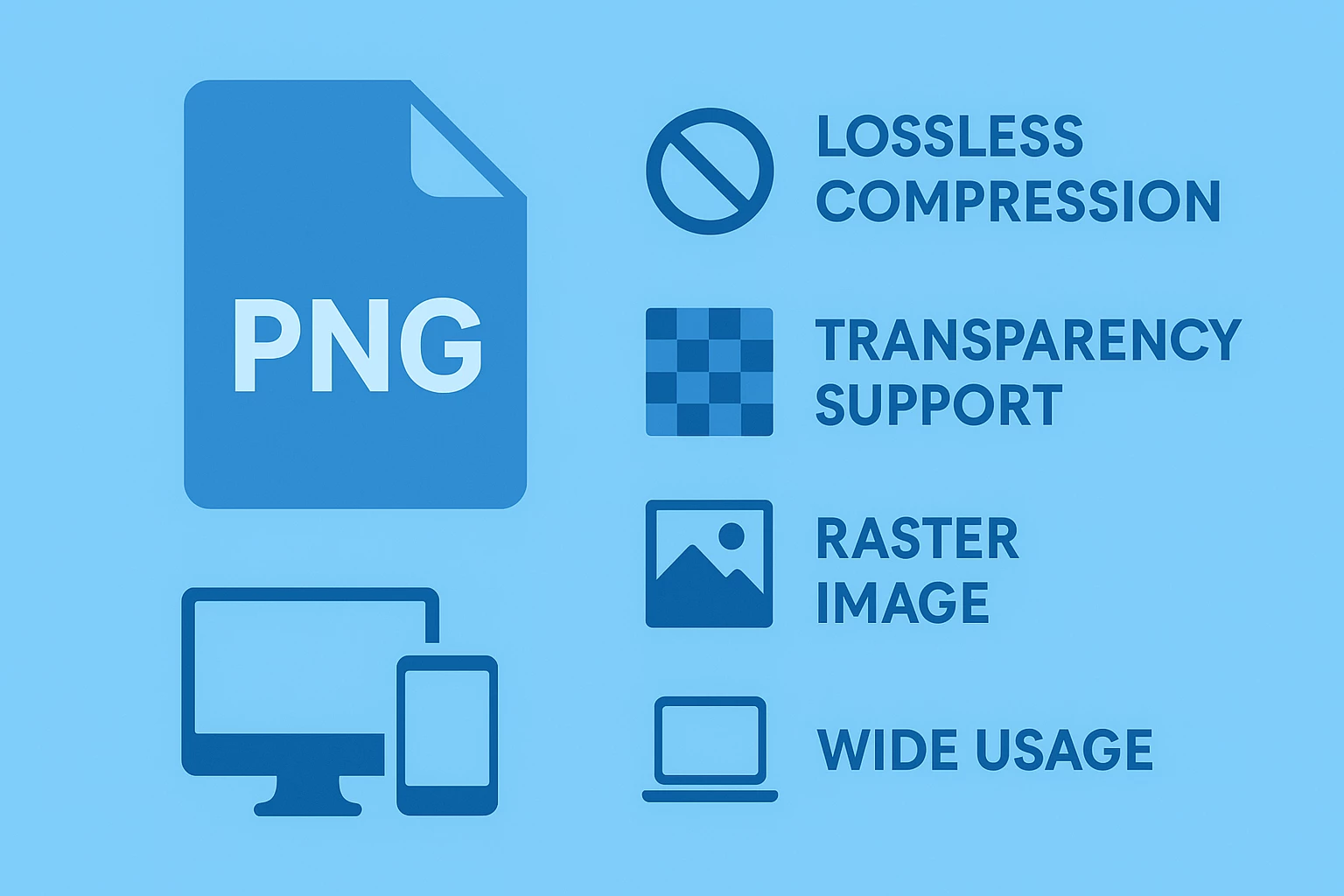
Another reason I rely on PNG is its support for transparency. It allows images to blend naturally with any background, which makes it perfect for design work where flexibility is important.
Internally, PNG stores image data in a structured way that protects both color depth and detail. It supports millions of colors and displays consistently across screens, browsers, and operating systems.
In short, PNG works by preserving clarity and precision without compromising usability; a rare balance that keeps it relevant even decades after its creation.
Convert MP4 to PNG with MConverter
Key Features of PNG#
PNG stands out for precision, flexibility, and reliability. It was created to fix the shortcomings of older image formats, giving designers and developers a way to preserve quality without sacrificing performance.
In contrast to formats that trade detail for smaller file sizes, PNG focuses on maintaining full image integrity. The balance between compression and accuracy keeps it widely used across different platforms.

Lossless Compression Explained#
PNG uses lossless compression, meaning it reduces file size without deleting any image data. In simple terms, the file becomes smaller, but every pixel remains exactly the same. I like to think of it as packing a suitcase efficiently while keeping every item inside intact.
Lossless compression differs from JPEG’s lossy approach, where data is permanently removed to make the file smaller. JPEG works well for photographs, but repeated edits and saves gradually lower image quality. Once a detail is removed, it cannot be restored.
PNG avoids that problem entirely. All original data stays preserved, allowing me to edit and save a PNG multiple times without any visible degradation. It remains my preferred format for digital art, design assets, and image archiving because every version looks as clean and accurate as the original.
Also Read: What Is a ZIP File: The Ultimate Guide
Transparency and Alpha Channel#
One reason I rely on PNG is its ability to manage transparency with precision, as it supports both full and partial transparency through an alpha channel. The alpha channel defines the transparency level of each pixel, creating smooth edges, subtle shadows, and natural blending with any background.
Such flexibility makes PNG ideal for logos, icons, and layered graphics. For example, when exporting a logo for a website, I never worry about an unwanted white or colored box appearing around it. The transparent background keeps the design clean and adaptable across different layouts.
The same applies to interface elements, overlays, and product visuals, all appearing polished and professional.
For designers, alpha transparency offers control and flexibility unavailable in flat, opaque formats. Whether creating a simple mark or a complex layered composition, transparency ensures seamless integration with surrounding elements.
High-Quality Rendering#
PNG is good at preserving gradients, fine details, and text clarity. The format supports a broad color range and renders visuals cleanly without introducing pixelation or visual noise. When I save illustrations, charts, or interface elements as PNG, the result matches the original work in sharpness, balance, and consistency across all devices.
Another advantage is the absence of compression artifacts, which often appear in JPEG images. Those blocky distortions can ruin smooth gradients or make text look blurry. PNG avoids such imperfections, keeping every element crisp and precise.
The difference becomes obvious when comparing both formats side by side. JPEG may offer smaller file sizes, but PNG maintains clean edges, natural transitions, and professional quality suitable for high-resolution designs.
Convert JPEG to PNG in Bulk with MConverter
Benefits of Using PNG#
PNG has earned its place as one of the most reliable image formats. It balances quality, flexibility, and compatibility, which makes it useful for both creative and technical work. I use it for web graphics, logos, screenshots, and design assets because it keeps every detail intact while staying easy to share and edit.
Another reason I value PNG is consistency. No matter where I open the file on a phone, desktop, or in a browser, it always looks the same. Colors stay accurate, edges stay sharp, and transparency remains flawless. Reliability saves time and prevents surprises when presenting designs or publishing visuals online.
Below are the main advantages that make PNG such a dependable format for modern workflows.
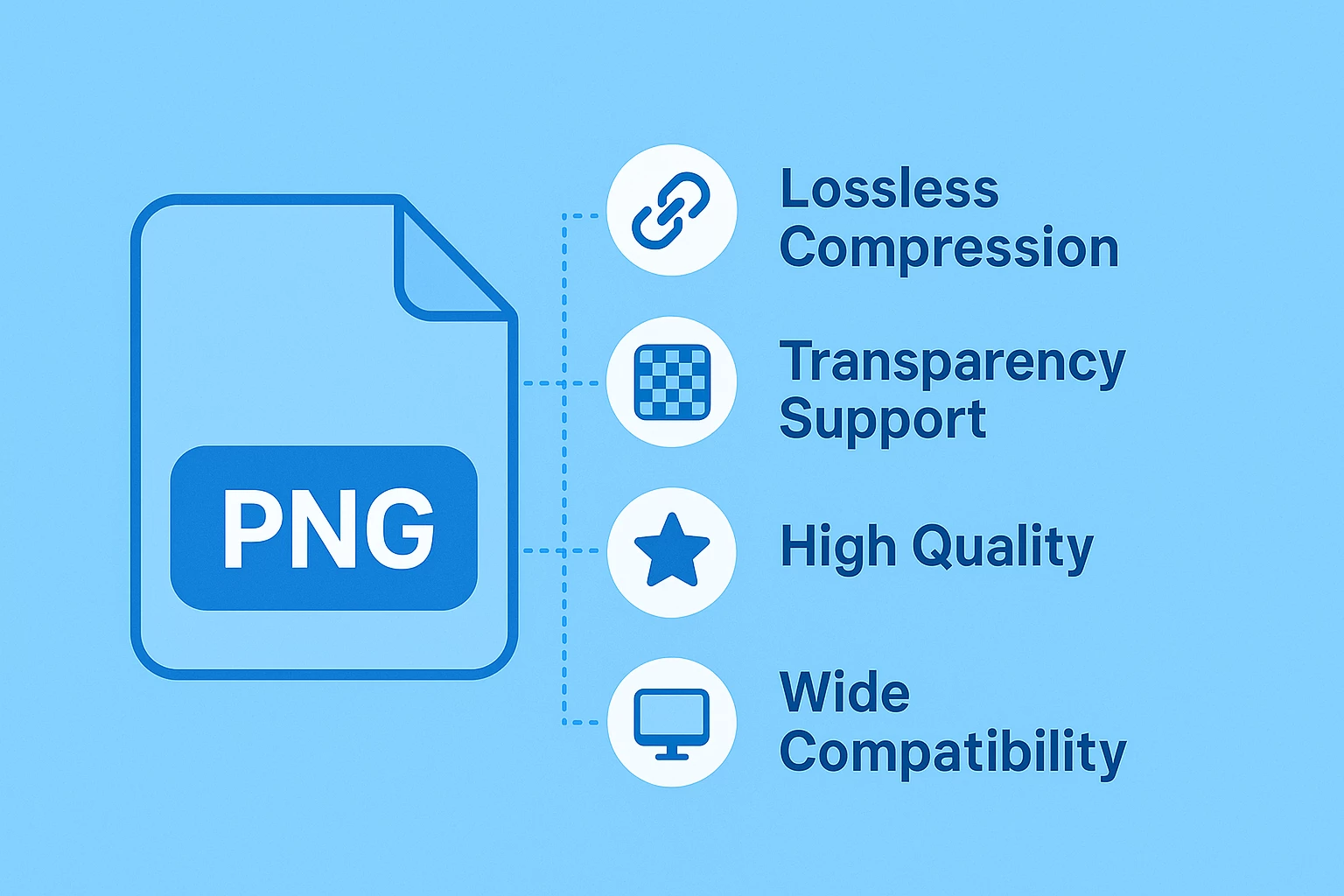
Perfect for Editing and Reuse#
PNG is my first choice when I plan to edit an image multiple times. With lossless compression, each save keeps the file as sharp as the original. I can crop, resize, or adjust colors without any loss in quality.
It’s ideal for long-term projects or layered designs that need repeated updates.
Convert MPO to PNG with MConverter
Ideal for Transparent and Layered Images#
PNG handles transparency better than almost any other format. It supports both full and partial transparency through its alpha channel, making it perfect for graphics that need to blend naturally with backgrounds.
Additionally, I often use PNG for web logos, icons, and overlays because it maintains clean edges and smooth gradients. When working on layered images, I can export each element separately without unwanted outlines or background colors.
Related Article: What Is MP4: A Guide for Beginners
Great for Screenshots and UI Elements#
When I capture screenshots or save interface designs, I always choose PNG. The format preserves small details like thin lines, gradients, and text without distortion. It also keeps colors accurate, which helps when testing layouts or sharing visuals with developers.
Plus, screenshots stored as PNGs look professional, clear, and ready for use in presentations, documentation, or product previews.
Universal Support#
PNG is one of the few formats I can trust to work anywhere without adjustments. It opens flawlessly across all major operating systems, including Windows, macOS, Linux, iOS, and Android. Every web browser supports it natively, so I never worry about compatibility when publishing visuals online.
Design tools also handle PNG with ease. Programs like Photoshop, Illustrator, Figma, and Canva recognize it instantly, keeping colors and transparency intact.
Whether I’m working on a high-end workstation or a phone, PNG displays consistently and accurately. Reliability across browsers, software, and devices makes it one of the most dependable formats for both professional and everyday use.
Convert PDF to PNG with MConverter
Limitations of PNG#
Even though I use PNG almost every day, I know it is not perfect for every situation. The format focuses on preserving quality, which sometimes creates challenges with file size and performance. Knowing where it falls short helps me decide when to use it and when another format is more practical.
The biggest limitation is file size. Since PNG uses lossless compression, it keeps every detail intact, which makes files heavier than formats like JPEG or WebP. I notice this most when exporting large images or uploading visuals to a website. Bigger PNG files can slow down page loading and take up unnecessary storage.
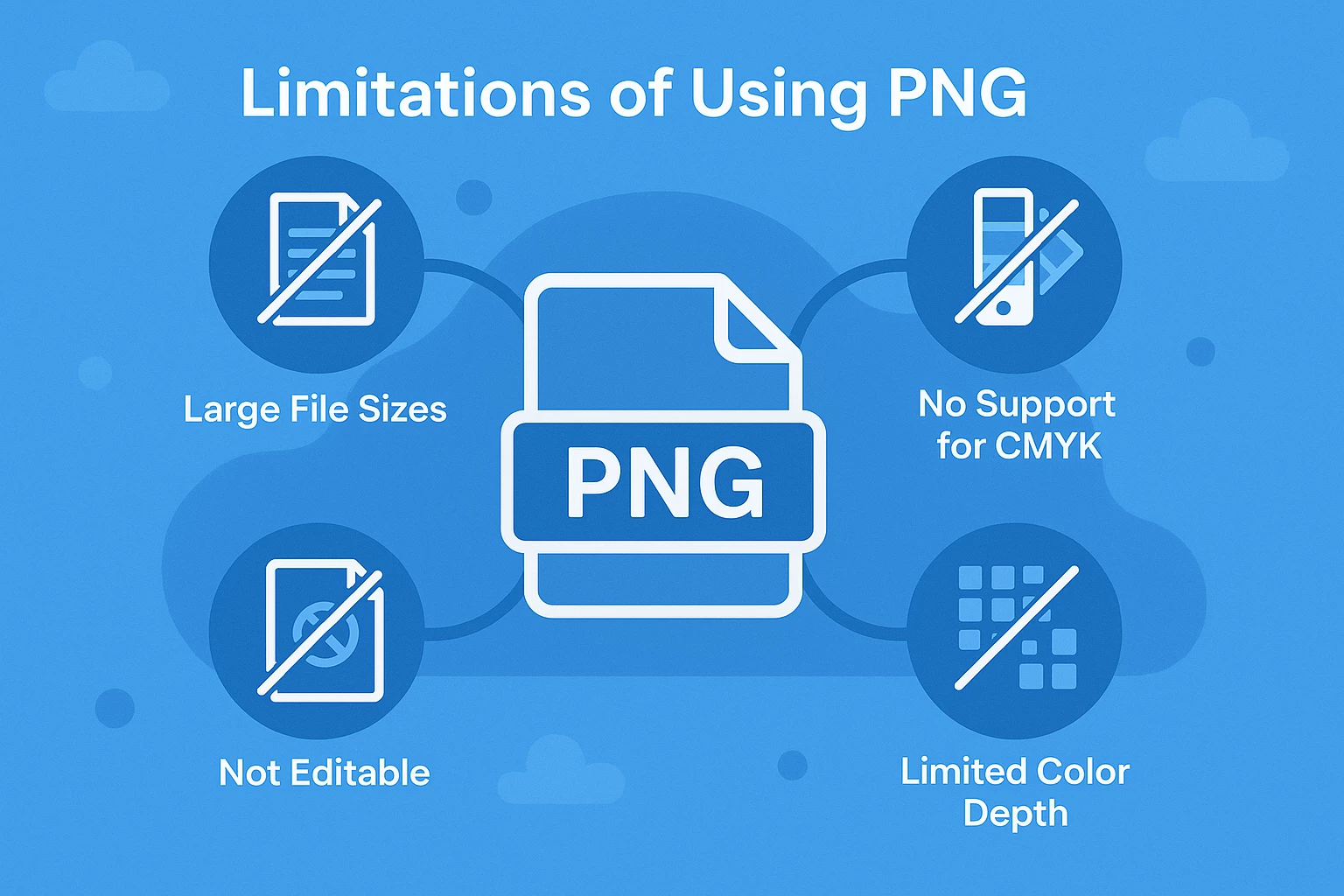
Another limitation is the lack of animation support. PNG works only with static images, so it cannot handle motion like GIF or video formats. There is an animated version called APNG, but not all browsers or programs support it. When I need simple animations, I use GIF or WebP instead.
PNG also struggles with photographs or complex visuals. It performs best with graphics, text, and designs that need transparency or clean edges. For detailed photos, JPEG or WebP usually provides smaller file sizes with little visible difference in quality.
Lastly, very large PNG files can slow down editing performance. When I work on high-resolution graphics, some design tools take longer to load or process them. In those cases, I resize or convert the image before editing to keep everything running smoothly.
Despite these drawbacks, I still rely on PNG when accuracy and transparency matter. It remains one of the most consistent formats for design and digital work, as long as I keep its limits in mind.
Convert MKV to PNG with MConverter
Common Uses of PNG#
I use PNG for almost every type of digital project. Its clarity, transparency, and reliability make it suitable for design, development, and communication. While it is not always the smallest format, the consistency of results makes it worth using in many everyday tasks.
One of the most common uses is web graphics. I often export logos, icons, and interface elements as PNGs because they look sharp on any background and display accurately across all browsers. The transparency feature makes web visuals cleaner and easier to integrate into layouts without visible edges or color mismatches.
PNG is also perfect for screenshots and tutorials. It captures every pixel with full clarity, keeping text readable and colors accurate. When I create visual guides, app previews, or documentation, I prefer PNG because it keeps details crisp even after resizing.

Another popular use is in graphic design and digital art. I save finished assets in PNG format when I need to preserve quality for printing, sharing, or layering in other tools. It is ideal for exporting icons, mockups, and interface prototypes where visual accuracy matters.
In addition, PNG works well for presentations and marketing materials. I use it to share visuals with clients and teammates since it opens correctly on every device without format issues. The quality stays consistent whether I am viewing it on a laptop or projecting it on a larger screen.
Finally, PNG is a reliable choice for archiving design assets. I keep final versions of logos, UI components, and illustrations as PNGs because the format preserves their exact appearance. Years later, I can reopen them without worrying about color shifts or quality loss.
Convert PNG to AI with MConverter
When to Use PNG (and When Not To)#
Knowing when to use PNG makes a big difference in how efficiently I handle images. The format delivers excellent quality and precision, but it is not always the most practical option. I choose it when I need accuracy, transparency, or clean rendering, and switch to lighter formats when speed and storage matter more.
I use PNG when working with graphics, text, or transparent elements. It is perfect for logos, icons, and interface components because every edge stays sharp. The alpha transparency also helps blend visuals smoothly into any background. PNG is my default choice when exporting visuals that must look the same on all devices and browsers.
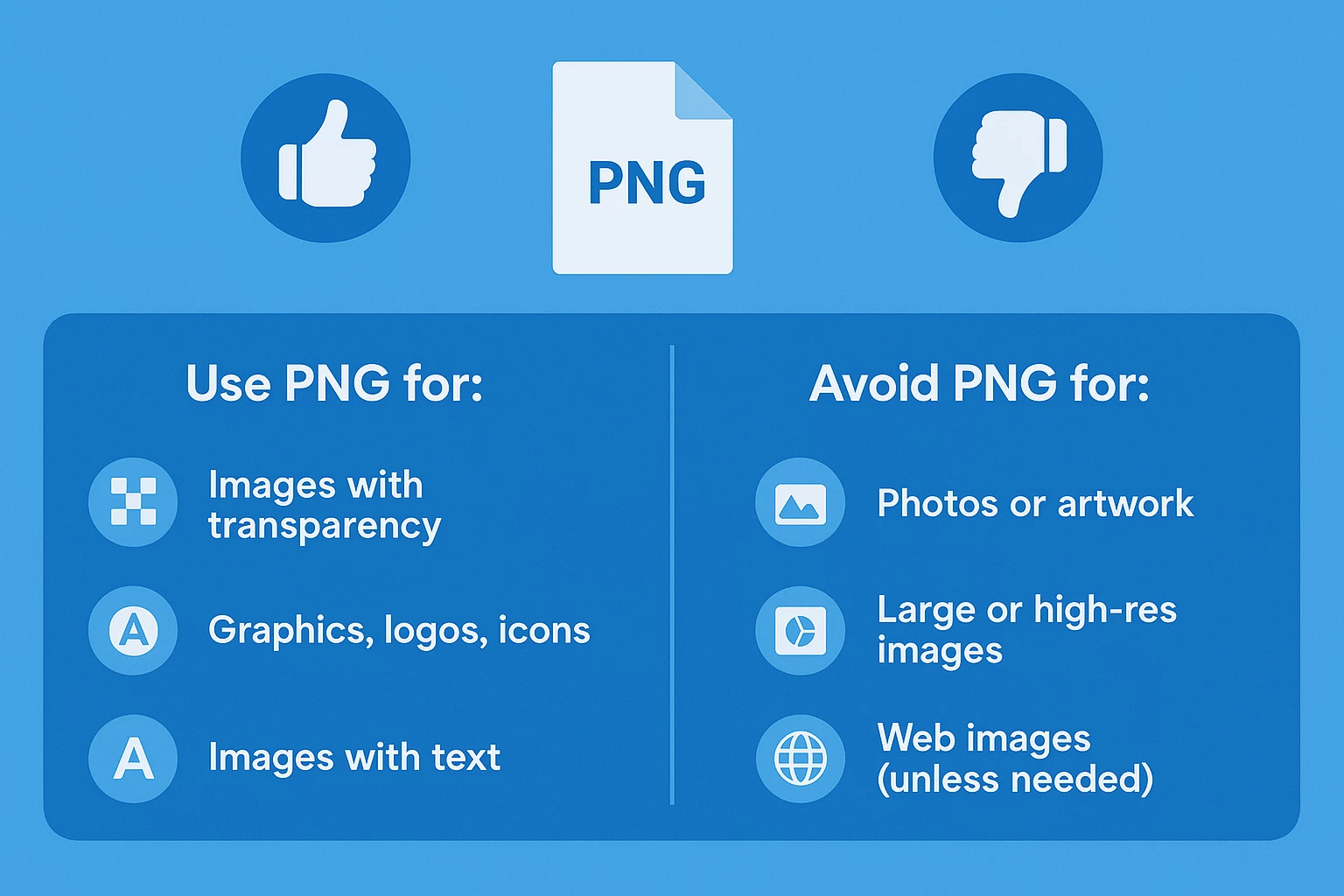
I also prefer PNG for screenshots, diagrams, and UI mockups. It preserves small details, gradients, and text clarity, which makes documentation and presentations look professional. Since PNG uses lossless compression, I can edit or crop the file multiple times without losing quality.
However, I avoid PNG for large photographs or full-page visuals. Lossless compression creates bigger files, which can slow down websites and take up unnecessary storage.
For images with lots of color variation, formats like JPEG or WebP are more efficient. They reduce file size significantly while keeping visual quality high enough for web use.
PNG is also not the best option for animated content. It supports only static images. When I need motion, I simply switch to GIF, WebP, or video formats that handle animation more effectively.
Convert 3G2 to PNG with MConverter
How to Optimize PNG Files for Web#
Optimizing PNG files keeps websites fast without sacrificing quality. A few small steps can make a big difference in performance.
I start by resizing images to their actual display size. Uploading oversized PNGs only slows down pages. Then I use tools such as TinyPNG or ImageOptim to compress files while keeping them visually identical.
For simple graphics, I often reduce color depth from 24-bit to 8-bit, which cuts file size without affecting appearance. I also remove unused transparency or flatten layers when possible, especially for icons or static visuals.
These quick adjustments keep PNGs lightweight, clean, and ready for web use. What’s more? The images stay sharp, but the pages load faster and perform better.
Best Practices for Using PNG in Design and SEO#
Using PNG effectively is about more than just image quality. It also involves smart choices that keep designs professional and websites performing well. Over time, I’ve developed a few habits that help me get the most out of PNG files without slowing things down.
I always start with purpose. PNG works best for visuals that need transparency, crisp edges, or detailed text. For photos or large backgrounds, I switch to formats like JPEG or WebP to save space. Choosing the right format early keeps projects lighter and easier to manage.
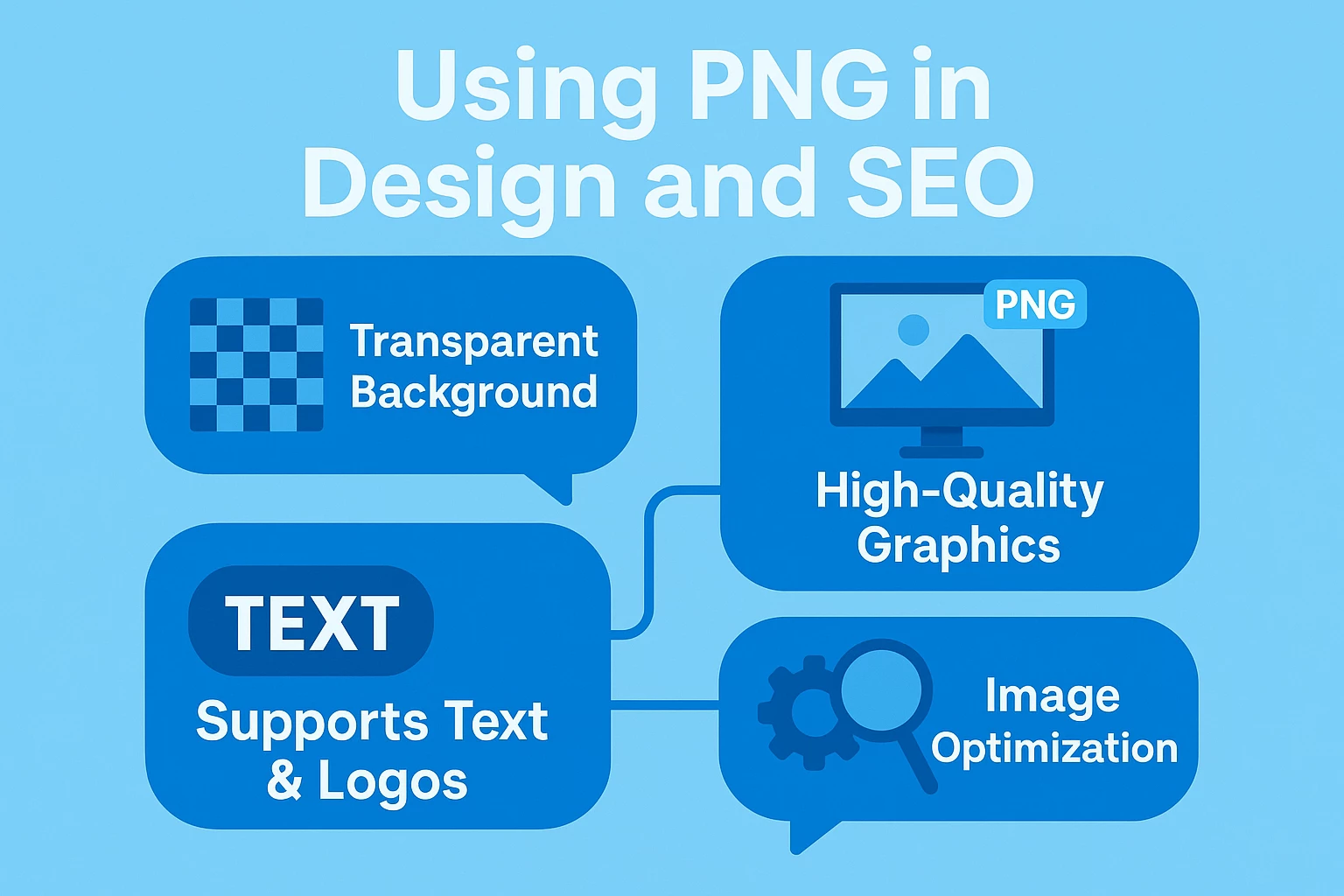
I also focus on naming and structure. Descriptive file names such as “product-icon.png” or “logo-header.png” make assets easier to find and improve SEO visibility. Search engines recognize clear filenames, which helps with image indexing.
Another important habit is optimizing for performance. I compress every PNG before uploading and check loading speed using tools like PageSpeed Insights. Faster pages perform better in search and create a smoother user experience.
For design consistency, I keep color profiles and resolution aligned with project requirements. I always preview PNGs on different screens to make sure colors appear the same everywhere.
Finally, I add alt text for accessibility and SEO. A simple, descriptive line helps users with screen readers and gives search engines more context about the image.
Convert DRAWIO to PNG with MConverter
How to Convert PNG Files#
Sometimes I need to convert a PNG into another format for web uploads, printing, or quick sharing. The simplest way I do it is through MConverter, a fast and secure file conversion platform that handles multiple formats at once.

With our tool, I can upload one or several PNG files, choose the output format such as JPG, WebP, PDF, or SVG, and download the converted versions in seconds.
Furthermore, the process runs directly in the browser, so there’s nothing to install. MConverter supports large files, keeps image quality intact, and automatically deletes uploads after four hours for privacy protection.
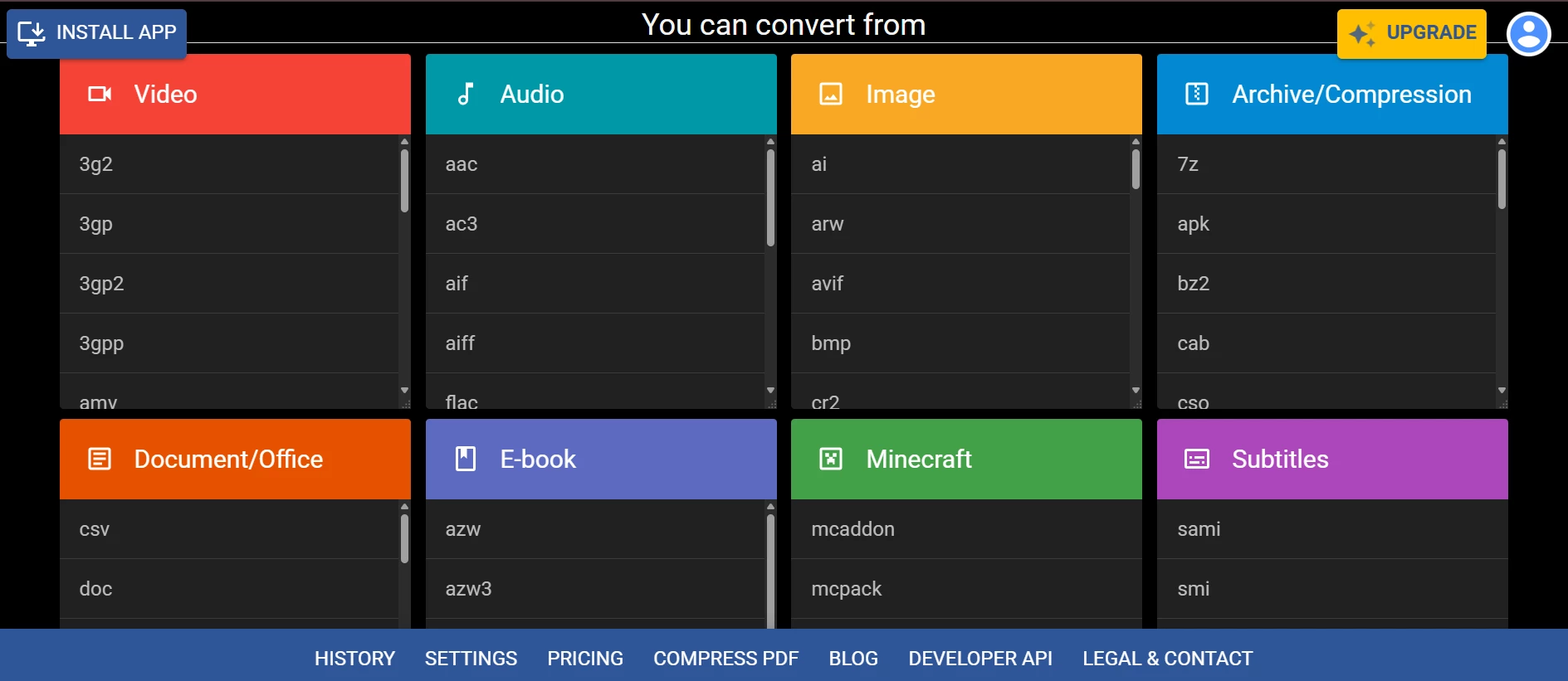
I often use it when I need quick conversions without opening design software. The encryption and temporary file storage keep everything safe, and the broad format support makes it useful for both everyday tasks and professional workflows.
Is PNG Better Than JPEG for Websites?#
It depends on the type of image. PNG is better for logos, icons, and graphics that need transparency or sharp edges. JPEG works better for photographs or large visuals since it produces smaller file sizes. I usually mix both formats, PNG for precision and clarity, JPEG for speed and lighter pages.
Can You Compress PNG Files Further Without Losing Quality?#
Yes. Tools like TinyPNG, ImageOptim, or Squoosh can reduce PNG file size without affecting image clarity. They remove unnecessary data while keeping every pixel intact. I often compress PNGs before uploading them to websites to keep pages fast and images crisp.
Does PNG Support Animation Like GIF?#
Not by default. Standard PNG files only store static images. There is a version called APNG (Animated PNG) that supports animation, but it is not fully supported across all browsers and platforms.
In case of animations, I usually use GIF or WebP instead, since both work more consistently online.
What’s the Difference Between 8-Bit and 24-Bit PNG?#
The main difference is color depth. 8-bit PNG supports up to 256 colors and is ideal for simple graphics or icons. 24-bit PNG supports over 16 million colors, which makes it better for detailed images, gradients, and realistic visuals. I choose 8-bit for lightweight designs and 24-bit when image quality matters more than file size.
How Do I Reduce the Size of a PNG File for Faster Loading?#
I usually start by resizing the image to its actual display size. Then I use compression tools like TinyPNG, ImageOptim, or MConverter to remove unnecessary data without losing quality. If you reduce the color depth from 24-bit to 8-bit also helps keep the file smaller while maintaining visual clarity.
Why Do Designers Prefer PNG for Logos?#
Designers prefer PNG because it supports transparency and preserves sharp edges. Logos saved as PNG blend smoothly with any background and keep colors accurate across devices. The format also uses lossless compression, so the image stays clean and professional no matter how many times it’s edited or exported.
Can I Print PNG Images Without Losing Quality?#
Yes. PNG images use lossless compression, so they keep full detail when printed. I always make sure the file resolution is high enough, usually 300 DPI or more, for clear results on paper. PNG works well for printing logos, graphics, and digital art, but for large photos or posters, TIFF or PDF may be more practical.
About the author
Mihael joined MConverter as a co-founder in 2023, bringing a vision to transform a tech tool into a product company built around meaningful user experience. With roots in B2B sales, product development, and marketing, he thrives on connecting the dots between business strategy and customer needs. At MConverter, he shapes the bigger picture - building the brand, inspiring teams, and pushing innovation forward with a can-do mindset. For Mihael, it’s not just about file conversions, but about creating experiences that deliver real impact.
Check out more articles
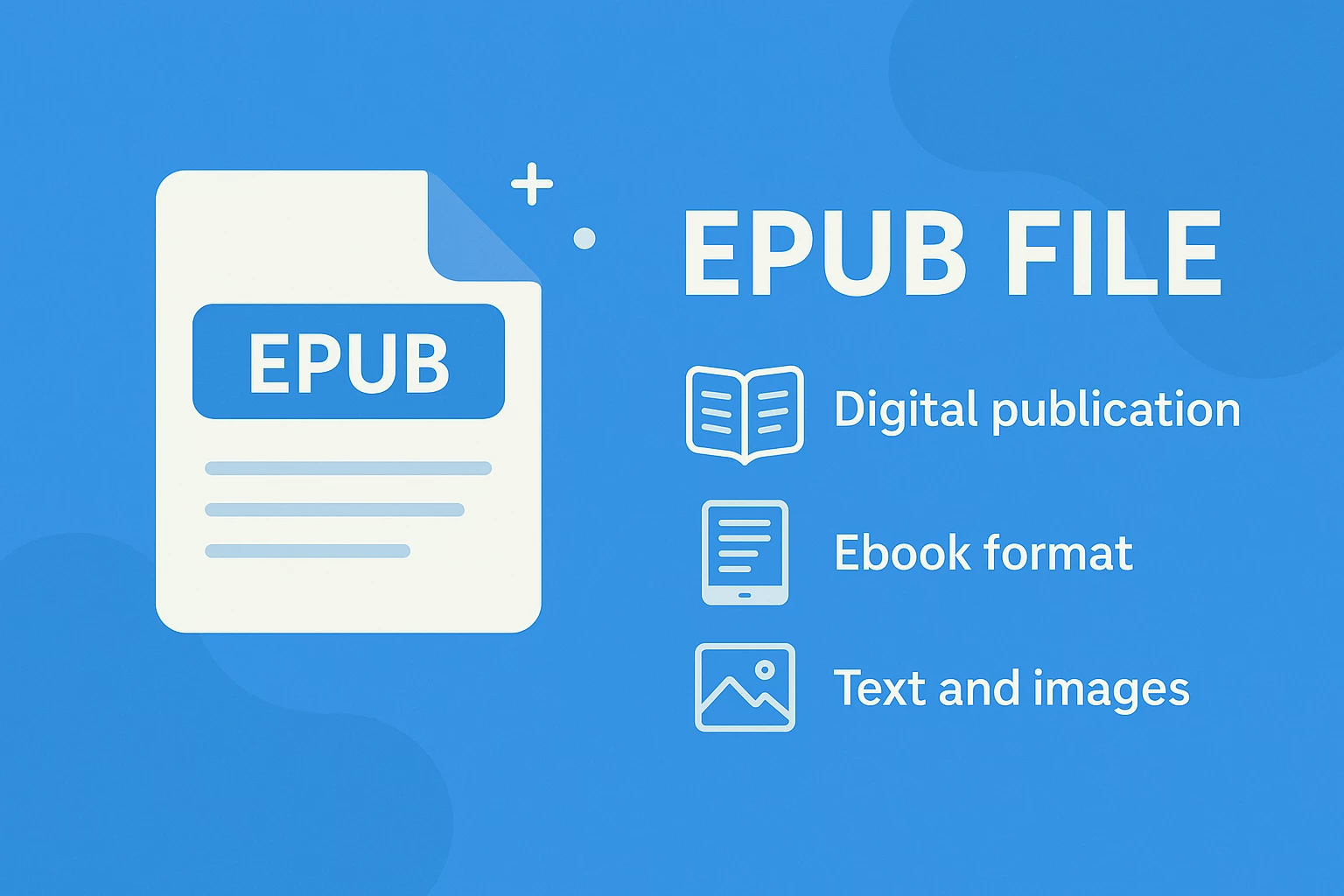
EPUB Files - What They Are & How to Open Them

What Is an ISO File? The Ultimate Guide for 2025
